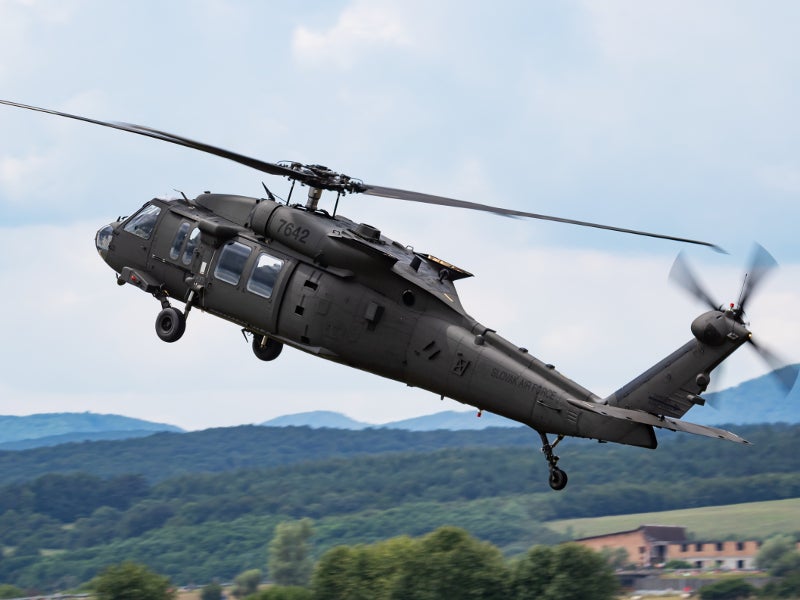Flight Ready: Ensuring Optimum Condition for Your UH 60 Helicopter
Flight Ready: Ensuring Optimum Condition for Your UH 60 Helicopter
Blog Article
Comprehending the Mechanics and Engineering Behind Uh 60 Helicopters
The UH-60 helicopter, generally referred to as the Black Hawk, stands as a peak of modern-day rotorcraft technology, symbolizing a blend of durable design and detailed auto mechanics. From its beginning to its existing iterations, the advancement of this airplane showcases a blend of innovation and practicality. As we peel back the layers of the UH-60's style, a world of complex systems and meticulous design comes to light. Understanding the auto mechanics and design behind this versatile airplane introduces a world where accuracy satisfies power, and where each element plays an essential function in achieving trip.
Background of UH-60 Helicopters
The history of UH-60 helicopters traces back to the late 1970s when the United States Military looked for a advanced and versatile utility helicopter to replace its aging fleet. In action to this requirement, the Sikorsky Airplane Firm established the UH-60 Black Hawk helicopter. Introduced in 1979, the UH-60 promptly ended up being a staple in military procedures due to its remarkable capacities.
The UH-60 was made to master a selection of objectives, including army transportation, clinical evacuation, digital war, and unique procedures. Its capacity to adapt to different functions made it a valuable asset to the U.S. uh 60. Military and other military pressures around the globe
For many years, the UH-60 system has undertaken a number of upgrades and variants to boost its efficiency and equal developing goal requirements. These helicopters have seen comprehensive service in problems such as the Gulf War, Afghanistan, and Iraq, showcasing their reliability and flexibility in varied operational settings. The UH-60's rich history is a testimony to its enduring legacy as a leading utility helicopter.

Engine and Power Systems
Making use of advanced propulsion modern technology, UH-60 helicopters are equipped with advanced engine and power systems to ensure optimum performance and integrity in a variety of operational situations. The UH-60, frequently referred to as the Black Hawk, is powered by 2 General Electric T700-GE-701D engines, each with the ability of providing up to 1,940 shaft horse power. These turboshaft engines give the required thrust for the helicopter to perform its goals efficiently, including army transport, clinical discharge, and battle support.

Rotor System and The Rules Of Aerodynamics
Exactly how do the rotor system and aerodynamics of UH-60 helicopters contribute to their operational effectiveness and trip abilities? The rotor system of the UH-60 helicopter plays a critical function in offering lift and propulsion.
Aerodynamics likewise play an essential role in the performance of UH-60 helicopters. The structured fuselage this article and blades blade design decrease drag, enabling the helicopter to attain greater speeds and far better gas effectiveness. The wind resistant style of the UH-60 likewise adds to its ability to operate in diverse ecological conditions, consisting of high elevations and hot temperatures.
Avionics and Flight Control Solution

In its complex coordination with the rotor system and aerodynamics of UH-60 helicopters, the avionics and trip control systems create a vital network of innovations shaping the airplane's functional abilities. Avionics include the digital systems used for communication, navigating, and keeping an eye on various airplane functions. In the UH-60, these systems consist of electronic display screens, communication radios, GPS navigation, weather radar, and auto-pilot systems. These avionics systems provide crucial details to the pilots, improving situational awareness and guaranteeing safe and effective procedure of the helicopter.
The flight control systems of the UH-60 are responsible for equating the pilot's inputs into the appropriate adjustments to the rotor system, guaranteeing secure trip and ability to move. These systems contain hydraulic actuators, servos, and computers that collaborate to control the tail and major rotors, as well as various other trip control surface areas. By specifically managing the helicopter's trip dynamics, these systems enable pilots to discover here perform a variety of goals, from transportation and search-and-rescue to battle procedures, with accuracy and self-confidence.
Function and Applications in Air Travel
Avionics systems in UH-60 helicopters incorporate a range of digital systems that help in navigation, communication, monitoring, and controlling numerous aircraft features. These systems include electronic screens, auto-pilot systems, communication radios, GPS navigating tools, and climate radar. Furthermore, these systems integrate safety and security features such as autopilot modes, terrain awareness alerting systems, and security enhancement systems to boost the overall safety and security and operational capabilities of the UH-60 helicopters in different goals, including troop transport, clinical evacuation, search and rescue, and aerial firefighting.
Conclusion
To conclude, the UH-60 helicopter is a flexible aircraft with an abundant history and advanced engineering. Its engine and power systems, rotor system, aerodynamics, avionics, and trip control systems all function together wikipedia reference to make it a dependable and efficient machine. The UH-60's duty and applications in aeronautics are huge, ranging from military operations to look and rescue missions. Its continued development and usage demonstrate its significance in the field of aeronautics (uh 60).
In its detailed coordination with the rotor system and aerodynamics of UH-60 helicopters, the avionics and trip control systems develop an essential network of modern technologies shaping the aircraft's operational abilities.The flight control systems of the UH-60 are liable for converting the pilot's inputs into the suitable modifications to the blades system, guaranteeing secure flight and maneuverability. Avionics systems in UH-60 helicopters include a range of digital systems that aid in navigating, interaction, tracking, and controlling numerous airplane functions. Additionally, these systems incorporate safety functions such as auto-pilot settings, surface awareness advising systems, and stability enhancement systems to boost the general security and functional capacities of the UH-60 helicopters in numerous goals, including troop transportation, clinical emptying, search and rescue, and aerial firefighting.
Its engine and power systems, blades system, the rules of aerodynamics, avionics, and trip control systems all function together to make it a dependable and efficient maker.
Report this page